Grand Prix (1966 film)
8.8 /10 1 Votes
100% Rotten Tomatoes Duration Language English | 7.2/10 IMDb 4.6/5 Amazon Genre Drama, Sport Initial DVD release July 11, 2006 Country United States | |||||||||||||||||||||||||||||||||
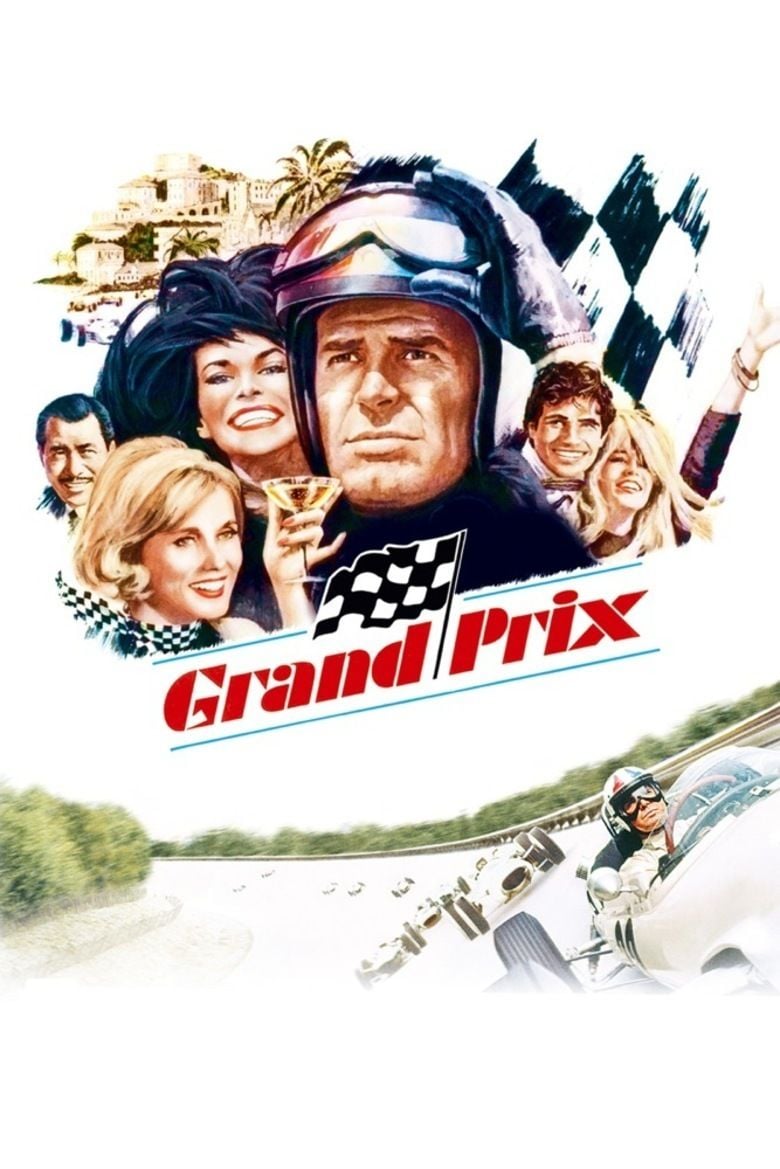 | ||||||||||||||||||||||||||||||||||
Release date December 21, 1966 (1966-12-21) Cast (Pete Aron), (Louise Frederickson), (Jean-Pierre Sarti), Toshir? Mifune (Izo Yamura), (Scott Stoddard), (Pat Stoddard)Similar movies Back to the Future , Back to the Future Part II , Back to the Future Part III , Rush , Cars , Cars 2 Tagline Cinerama sweeps YOU into a drama of speed and spectacle! | ||||||||||||||||||||||||||||||||||
Grand prix movie 1966 trailer by nicolas boucher
Grand Prix is a 1966 American drama film about motorsports featuring an international ensemble cast. The picture was directed by John Frankenheimer with music by Maurice Jarre and stars James Garner, Eva Marie Saint, Yves Montand, Brian Bedford, Jessica Walter and Antonio Sabàto. Toshiro Mifune has a supporting role as a race team owner, inspired by Soichiro Honda. The picture was photographed in Super Panavision 70 by Lionel Lindon, and presented in 70 mm Cinerama in premiere engagements. Its unique racing cinematography – in part credited to Saul Bass – is one of the main draws of the film.
Contents
- Grand prix movie 1966 trailer by nicolas boucher
- Grand prix movie 1966 spa
- Plot
- Cast
- Production
- Reception
- Accolades
- References
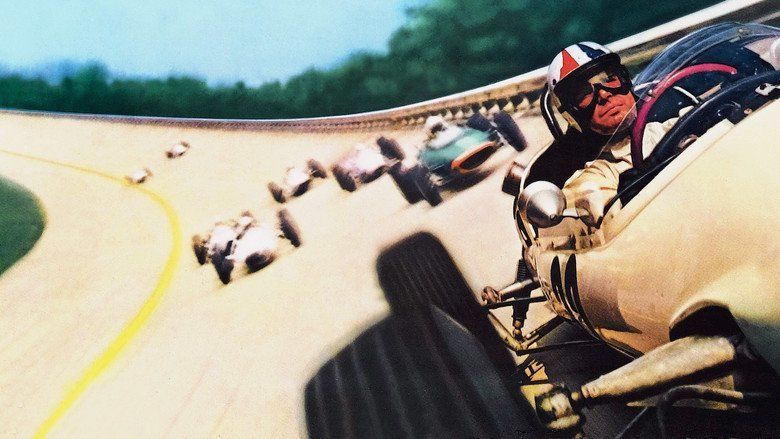
The film includes real-life racing footage and cameo appearances by drivers including Formula One World Champions Phil Hill, Graham Hill, Juan Manuel Fangio, Jim Clark, Jochen Rindt and Jack Brabham. Other drivers who appeared in the film include Dan Gurney, Richie Ginther, Joakim Bonnier, Bruce McLaren and Jo Siffert.
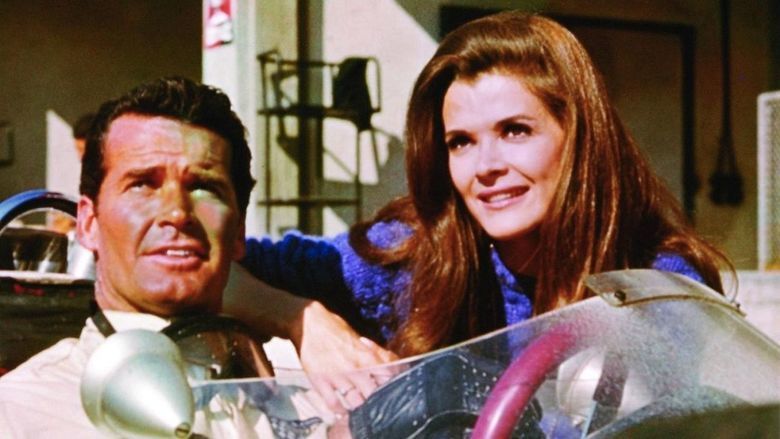
One of the ten highest grossing films of 1966, Grand Prix won three Academy Awards for its technical achievements. The film was released on DVD, HD DVD, and Blu-ray Disc in May 2011.
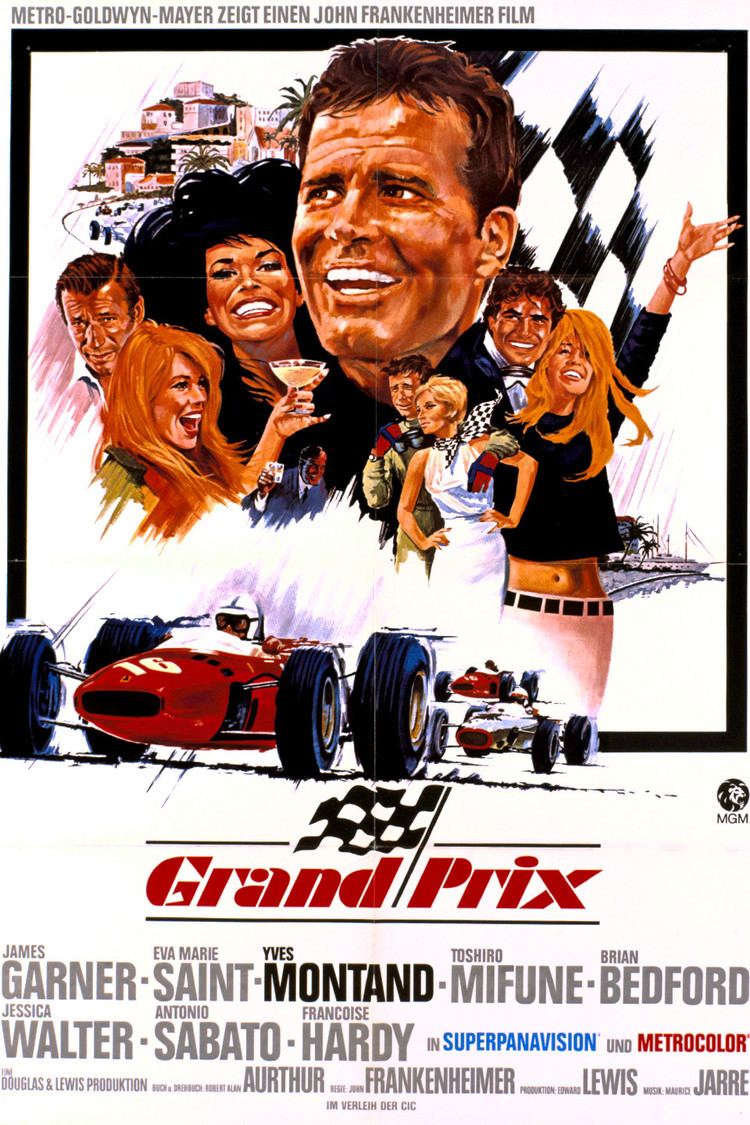
Grand prix movie 1966 spa
Plot

The story follows the fate of four Formula One drivers through a fictionalized version of the 1966 Formula One season:
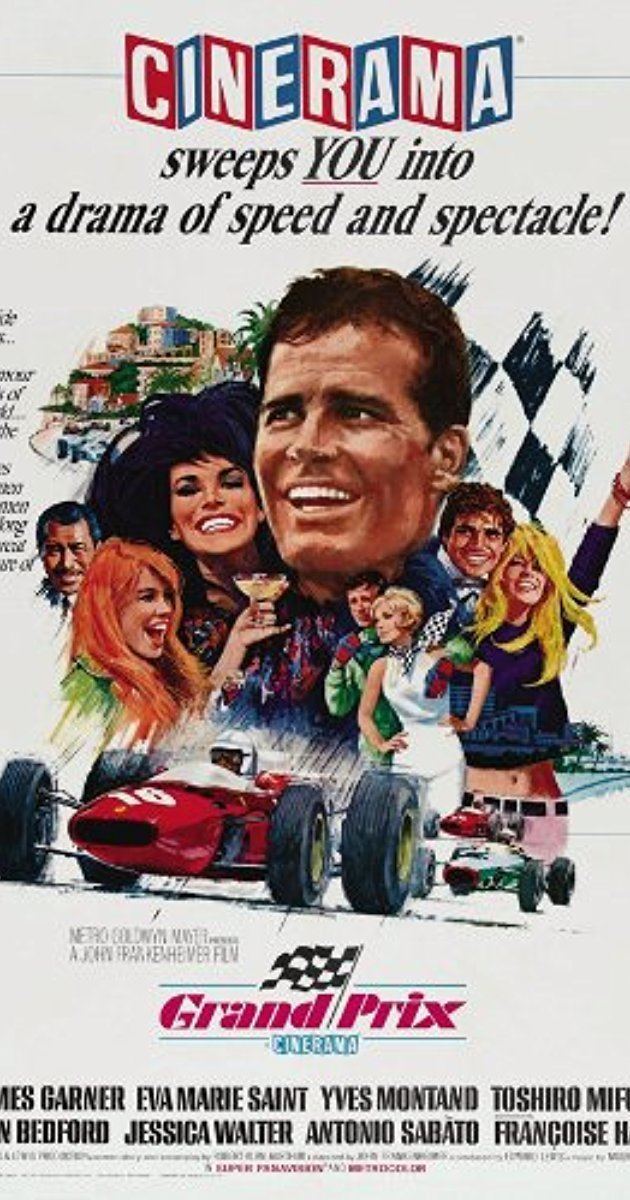
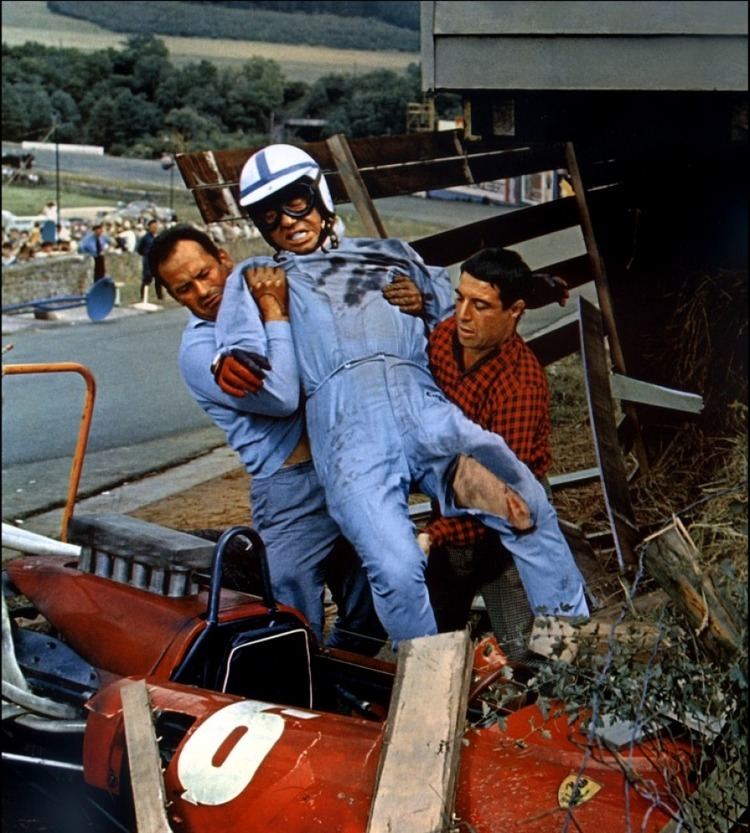
Subplots in the film revolve around the women who try to live with or love the racers with dangerous lifestyles. The married Sarti begins an affair with an American magazine writer, Louise Frederickson, who initially has little interest in motorsports. Aron has a brief romance with Stoddard's unhappy wife Pat while Stoddard deals with living in the shadow of his family's history, being unsure if he can live up to the prestigious racing legacy of his late brother.

The story concludes with one last race, its winner becoming world champion. Sarti's wife, Monique, shows up just before it begins, coming face-to-face with Louise and telling Sarti she will never grant him a divorce even as Sarti wishes to end their unhappy union. Sarti's car has technical difficulties at the race's start, with the other drivers facing a close contest for first. Sarti is then suddenly killed in a spectacular crash. His racing partner, Barlini, is flagged off the course by Ferrari's team leader, Manetta, resulting in a tight race between Aron and Stoddard to the finish line, Aron getting the checkered flag. While a jubilant Aron magnanimously invites Stoddard to the winner's platform to join him, the shock of Sarti's death takes its toll on the celebration. The film ends with Aron, alone, walking along the circuit of the final racetrack.
Cast


Uncredited Cast
Non-actors appearing include broadcaster Raymond Baxter, who interviews Nino Barlini after he wins the British Grand Prix at Brands Hatch.
Production
Director John Frankenheimer later said when he made the film he had the "choice of making a Grand Hotel type picture or a Test Pilot type picture" and he chose the former.
The making was a race itself as fellow Hollywood icons Steve McQueen and John Sturges planned to make a similar movie exploring the life of racers, with the McQueen/Sturges team initially using the title Day of the Champion. Due to their contract with the German motorsports complex Nürburgring, Frankenheimer had to turn over 27 reels shot there to Sturges. Frankenheimer got ahead in schedule terms anyway, however, and McQueen's project ran into a wide variety of problems. Said German race track was only mentioned briefly in Grand Prix. McQueen's racing film eventually took the title Le Mans, with it seeing a 1971 release (five years after Grand Prix).
The production team began by using connections to racing figures Dan Gurney, Phil Hill, and Carroll Shelby, who all assisted them in trying to break through an otherwise reluctant European establishment. The filming process meant disrupting vital practice runs and otherwise getting in the way of the actual racers' activities. The Grand Prix team initially faced a particularly lukewarm response from the Ferrari company, with the firm concerned that the movie would overly sensationalize their work. Frankenheimer cut together approximately thirty minutes of detailed footage after filming in Monte Carlo, temporarily halted the movie's production, and sent the short piece over to the company's management. He received such a positive response that he gained unprecedented access, being allowed to shoot inside Ferrari's production floor alongside the real racing vehicles. The director used this budding relationship to push other entities to help with the film-making process. Many real-life drivers of the era ended up making cameo appearances in Grand Prix, several even briefly speaking alongside the actors.
The F1 cars in the film are mostly mocked-up Formula Three cars made to look like contemporary Formula One models, although the film also used footage from actual F1 races. Because Yamura Motors is a fictional race team, the producers struck a deal with Bruce McLaren's newly-formed McLaren team to have his car, the McLaren M2B, to be painted with Yamura's colors. Some of the footage was captured by Phil Hill, the 1961 World Champion, who drove modified camera cars in some sessions during the 1966 Monaco and Belgian Grands Prix. This was some of the earliest experimentation with in-car cameras for F1, particularly in terms of first-person shots aimed at putting the audience in the position of the racers.
The actual level of driving ability possessed by the movie's actors varied wildly. Bedford couldn't drive at all and was only ever in the car for close-up type shots, with the production's driving instructor calling the actor's situation "hopeless". Montand and Sabàto faced significant challenges, both of them struggling with even basic skills. Garner, on the other hand, proved competent enough that he trained exclusively with iconic Shelby Cobra driver Bob Bondurant, with the actor's interest in cars growing greatly as a direct result of his involvement in the film. Garner's talents on the road became strong enough that some of the professional drivers, including Bondurant, remarked that the actor could have been a successful Grand Prix driver if he had not gone into making films; director Frankenheimer himself agreed. Garner's devotion to the part caused him to do his own stunt in the scene in which a fuel leak in his vehicle sets it on fire. Garner's car was fitted with a higher rollbar and had no seat, since he was too tall to fit in a contemporary F1 car.
The helmet design that James Garner's character uses is that of then-Grand Prix race driver Chris Amon from New Zealand. The only difference was a silhouette of a Kiwi bird that was normally on the side of Amon's helmet that was left off Garner's, as his character was an American. Brian Bedford's character used a helmet design that was the same as that of real life 1966 BRM driver Jackie Stewart. As Bedford couldn't drive, this was done so that they could shoot footage of Stewart driving the BRM (with a balaclava over his face to hide that it wasn't actually Bedford driving) and pass it off as Bedford.
Circuits featured in the film include Circuit de Monaco (Monaco), Clermont-Ferrand (France), Circuit de Spa-Francorchamps (Belgium), Circuit Park Zandvoort (Netherlands), Brands Hatch (United Kingdom), and Autodromo Nazionale Monza (Italy). The Nürburgring (West Germany), Watkins Glen International (USA), and the Autódromo Hermanos Rodríguez (Mexico) were all mentioned in the film but there was no footage shown.
The camera car used on the tracks was a Ford GT40 driven by racing figure Phil Hill. Cameras were mounted at the front and/or rear of the GT40 with front and rear body panels being removed as necessary. Aerial shots were filmed from an Alouette III helicopter. These shots were taken so close to the actual roads that the cameraman's shoes became stained with bits of greenery from the tips of nearby trees.
Although making various technological innovations in their filmmaking, numerous difficulties bogged down the movie's production. During filming with wet roads, several cars lost control to the point that one driver broke his shoulder bone and another nearly careened into the upstairs window of a house. The production team often decided to include unplanned accidents caught on film in the final movie, coming back hours later to shoot before-and-after scenes so that things fit in the final cut. For major accidents that were part of the story-line, the crew constructed a special cannon-like device that could fire gutted cars a considerable distance.
During the making of the film, both Frankenheimer and Garner were interviewed by television personality Alan Whicker for the BBC series Whicker's World.
Reception
The film earned $7 million in North American rentals in 1967.
Upon its 1966 release, Bosley Crowther called the film "a smashing and thundering compilation of racing footage shot superbly at the scenes of the big meets around the circuit, jazzed up with some great photographic trickery ... Mr. Frankenheimer belts you with such a barrage of magnificent shots of the racing cars, seen from every angle and every possible point of intimacy, that you really feel as though you've been in it after you've seen this film. Furthermore, the director and Saul Bass fill that mammoth screen from time to time with multiple graphics and montages that look like movies at a world's fair. Triple and quadruple panels and even screen-filling checkerboards ... hit the viewer with stimulations that optically generate a sort of intoxication with racing. It's razzle-dazzle of a random sort, but it works." However, Crowther concluded "the big trouble with this picture ... is that the characters and their romantic problems are stereotypes and clichés... You come away with the feeling that you've seen virtually everything there is to see in grand-prix racing, except the real guys who drive those killer cars."
Forty-five years later, upon its release on Blu-ray Disc, The New York Times reviewed the film again, with Dave Kehr saying "considered purely from a technical point of view, the new disc is a beauty, with crisp, richly textured images that do justice to the original 65-millimeter Super Panavision format, and a roaringly dimensional soundtrack ... As a movie, though, Grand Prix was never that grand. First shown as a reserved-seat, road-show attraction in Cinerama theaters, it is little more than a 176-minute version of the roller-coaster ride This Is Cinerama that introduced the format in 1952, a high-speed tour of the principal stops on the Formula One tour, with the spectator, as often as possible, strapped into the driver's seat."
Accolades
At the 39th Academy Awards, Grand Prix won Oscars for Best Sound Effects (Gordon Daniel), Best Film Editing and Best Sound (Franklin Milton). John Frankenheimer was nominated for Outstanding Directing by the Directors Guild of America.
References
Grand Prix (1966 film) WikipediaGrand Prix (1966 film) IMDbGrand Prix (1966 film) Rotten TomatoesGrand Prix (1966 film) Amazon.comGrand Prix (1966 film) themoviedb.org
